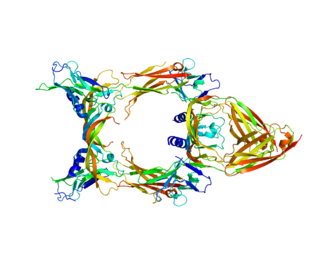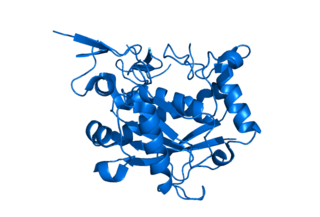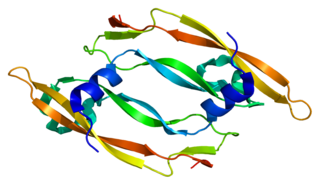Vascular endothelial growth factor (VEGF), originally known as vascular permeability factor (VPF), is a signal protein produced by many cells that stimulates the formation of blood vessels. To be specific, VEGF is a sub-family of growth factors, the platelet-derived growth factor family of cystine-knot growth factors. They are important signaling proteins involved in both vasculogenesis and angiogenesis.

Angiopoietin is part of a family of vascular growth factors that play a role in embryonic and postnatal angiogenesis. Angiopoietin signaling most directly corresponds with angiogenesis, the process by which new arteries and veins form from preexisting blood vessels. Angiogenesis proceeds through sprouting, endothelial cell migration, proliferation, and vessel destabilization and stabilization. They are responsible for assembling and disassembling the endothelial lining of blood vessels. Angiopoietin cytokines are involved with controlling microvascular permeability, vasodilation, and vasoconstriction by signaling smooth muscle cells surrounding vessels. There are now four identified angiopoietins: ANGPT1, ANGPT2, ANGPTL3, ANGPT4.

Vascular endothelial growth factor receptor 1 is a protein that in humans is encoded by the FLT1 gene.

Cadherin 5, type 2 or VE-cadherin also known as CD144, is a type of cadherin. It is encoded by the human gene CDH5.

Neuropilin 2 (NRP2) is a protein that in humans is encoded by the NRP2 gene.

Vascular endothelial growth factor C (VEGF-C) is a protein that is a member of the platelet-derived growth factor / vascular endothelial growth factor (PDGF/VEGF) family. It is encoded in humans by the VEGFC gene, which is located on chromosome 4q34.

G-protein coupled receptor 4 is a protein that in humans is encoded by the GPR4 gene.

Neuropilin-1 is a protein that in humans is encoded by the NRP1 gene. In humans, the neuropilin 1 gene is located at 10p11.22. This is one of two human neuropilins.

RhoC is a small signaling G protein, and is a member of the Rac subfamily of the family Rho family of GTPases. It is encoded by the gene RHOC.

A disintegrin and metalloproteinase with thrombospondin motifs 1 is an enzyme that in humans is encoded by the ADAMTS1 gene.

C-fos-induced growth factor (FIGF) is a vascular endothelial growth factor that in humans is encoded by the FIGF gene.

Protein tyrosine phosphatase type IVA 3 is an enzyme that in humans is encoded by the PTP4A3 gene.

Neuronal cell adhesion molecule is a protein that in humans is encoded by the NRCAM gene.

Semaphorin-3F is a protein that in humans is encoded by the SEMA3F gene.

Alpha-N-acetylneuraminide alpha-2,8-sialyltransferase is an enzyme that in humans is encoded by the ST8SIA1 gene.

Vascular endothelial growth factor B also known as VEGF-B is a protein that, in humans, is encoded by the VEGF-B gene. VEGF-B is a growth factor that belongs to the vascular endothelial growth factor family, of which VEGF-A is the best-known member.

Chloride channel accessory 2 is a protein that in humans is encoded by the CLCA2 gene.

Early growth response protein 3 is a protein in humans, encoded by the EGR3 gene.

Vascular endothelial growth factor A (VEGF-A) is a protein that in humans is encoded by the VEGFA gene.

In molecular biology mir-126 is a short non-coding RNA molecule. MicroRNAs function to regulate the expression levels of other genes by several pre- and post-transcription mechanisms.























